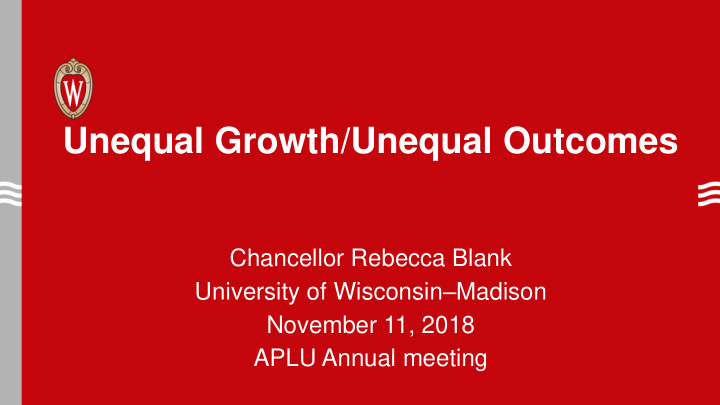



Unequal Growth/Unequal Outcomes Chancellor Rebecca Blank University of Wisconsin – Madison November 11, 2018 APLU Annual meeting
Economic growth is important
Annual Real GDP Growth Rates 4.0 3.7 3.6 3.5 3.5 Annual Growth Rate (%) 3.0 2.8 2.5 2.0 1.6 1.5 1.0 0.5 0.0 1970-79 1980-89 1990-99 2000-09 2010-18 Source: Bureau of Economic Analysis, based on chained (2012) dollars
No single institution in our nation is more important to long-term economic growth than the public research university
In recent decades, economic growth has translated into income growth only among those in the top half of the income distribution
Mean Household Income Within Quintiles $450,000 $416,520 Top 5 Percent $400,000 $350,000 $300,000 $250,000 $233,895 Highest 20% $200,000 $150,000 $101,570 60% to 80% $100,000 40% to 60% $63,572 $50,000 $37,293 20% to 40% $13,775 Bottom 20% $0 1979 1980 1981 1982 1983 1984 1985 1986 1987 1988 1989 1990 1991 1992 1993 1994 1995 1996 1997 1998 1999 2000 2001 2002 2003 2004 2005 2006 2007 2008 2009 2010 2011 2012 2013 2014 2015 2016 2017 2018 Source: U.S. Census Bureau, Current Population Survey, 1968 to 2018 Annual Social and Economic Supplements 2018 Dollars
How do we assure more workers can benefit from economic growth? 1. Improve jobs 2. Provide greater economic support to low-wage workers 3. Improve workers/Increase skill levels
Those who have benefited from economic growth are primarily those with college degrees
Male Median Cumulative Earnings by Birth Cohort and Education, Ages 43-47 Advanced Degree $1,000,000 College $900,000 Degree $800,000 Some $700,000 College $600,000 High School $500,000 Degree $400,000 High School $300,000 Drop Out $200,000 $100,000 $0 1960-64 Source: Educational Attainment and Earnings Inequality Among US-Born Men, Urban Institute
Male Median Cumulative Earnings by Birth Cohort and Education, Ages 43-47 Advanced Degree $1,000,000 College $900,000 Degree $800,000 Some $700,000 College $600,000 $500,000 High School Degree $400,000 High School $300,000 Drop Out $200,000 $100,000 $0 1940-44 1960-64 Source: Educational Attainment and Earnings Inequality Among US-Born Men, Urban Institute
If we raise skills by providing post- high school education to more citizens, we can stimulate greater economic growth, with broader benefits Even students on the margin benefit from higher education
The need to increase skills is even more important when you look at the inequalities in access and completion of higher education by group
Inequality in Educational Achievement, 2018 Percentage of the Population 25-29 Years Old 70% High School Degree 59% 60% 55% 50% 42% Associate’s 40% No High 33% Degree School 30% Degree Bachelor’s 18% 17% Degree 20% 15% 10% 10% 10% 10% 8% 10% 5% 4% 3% Advanced Degree 0% White Black Hispanic Source: National Center for Education Statistics, Digest of Education Statistics
Key point #1: It’s largely not initial access, but completion that is the problem. 90% of high school grads start some post-high school training.
Key point #2: This is largely about completion at public schools. The elite privates are pretty irrelevant.
Total Undergraduate Fall Enrollment All Degree-Granting Institutions 2016 5% Private, For- Profit Private, 17% Nonprofit Public 78% Source: National Center for Education Statistics, Digest of Education Statistics
Getting students to complete and graduate is not a huge mystery. Four major components: • Affordability • Teaching/curriculum • Advising/counseling • Support of family/friends
Affordability • Necessary but not sufficient • Linked to time to completion • Simple messaging matters
Side comment on Student Debt • Not a global problem; focused in for- profit & 2-yr schools • Greatest defaults among those with less debt • 4-year publics have seen only modest debt increases Economics comment: Debt is a good thing when used correctly!
Teaching/Curriculum • We do a bad job of teacher training and support • Coherent curriculum matters, which must be well communicated
Advising/Mentoring • Expect four year completion • Target extra help to low income/first gen students • Use new technologies to coach • Establish strong transfer programs from 2-year schools • Don’t forget career advising
Budget cuts and public attacks on higher education are not helpful in getting any of this done.
If we want the U.S. to thrive in the decades ahead we need to support public institutions of higher education and they need to be accountable for student completion
THANK YOU. 24
Recommend
More recommend